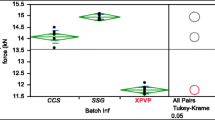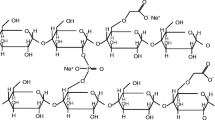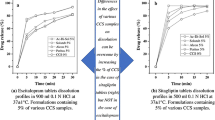Abstract
Spironolactone is a drug derived from sterols that exhibits an incomplete oral absorption due to its low water solubility and slow dissolution rate. In this study, formulations of spironolactone with four disintegrants named as croscarmellose sodium, crospovidone, sodium starch glycolate and microcrystalline cellulose II (MCCII) were conducted. The effect of those disintegrants on the tensile strength, disintegration time and dissolution rate of spironolactone-based compacts was evaluated using a factorial design with three categorical factors (filler, lubricant, and disintegrant). The swelling values, water uptake and water sorption studies of these disintegrants all suggested that MCCII compacts disintegrate by a wicking mechanism similar to that of crospovidone, whereas a swelling mechanism was dominant for sodium starch glycolate and croscarmellose sodium. The disintegration time of MCCII and sodium starch glycolate remained unchanged with magnesium stearate. However, this lubricant delayed the disintegration time of crospovidone and croscarmellose sodium. MCCII presented the fastest disintegration time independent of the medium and lubricant employed. The water sorption ratio and swelling values determined sodium starch glycolate followed by croscarmellose sodium as the largest swelling materials, whereas crospovidone and MCCII where the least swelling disintegrants. The swelling property of sodium starch glycolate and croscarmellose sodium was strongly affected by the medium pH. The disintegration time of spironolactone compacts was faster when starch was used as a filler due to the formation of soft compacts. In this case, the type of filler employed rather than the disintegrant had a major effect on the disintegration and dissolution times of spironolactone.






Similar content being viewed by others
REFERENCES
Yuancai D, WaiKiong NG, Shoucang S, Sanggu K, Reginald BH. Preparation and characterization of spironolactone nanoparticles by antisolvent precipitation. Int J Pharm. 2009;375:84–8.
Limayem BI, Charcosset C, Sfar S, Fessi H. Preparation and characterization of spironolactone-loaded nanocapsules for pediatric use. Int J Pharm. 2006;325:124–31.
Niazi S. Textbook of biopharmaceutics and clinical pharmacokinetics. New York: Appleton; 2002.
Zhao N, Augsburger LL. Functionality comparison of 3 classes of superdisintegrants in promoting aspirin tablet disintegration and dissolution. AAPS PharmSciTech. 2005;6:E634–40.
Zhao N, Augsburger LL. The influence of granulation on superdisintegrant performance. Pharm Dev Technol. 2006;11:47–53.
Massimo G, Catellani PL, Santi P, Bettini R, Vaona G, Bonfanti A, et al. Disintegration propensity of tablets evaluated by means of disintegrating force kinetics. Pharm Dev Technol. 2000;5:163–9.
Ferrero C, Munoz N, Velasco M, Muñoz-Ruiz A, Jimenez Castellanos R. Disintegrating efficiency of croscarmellose sodium in a direct compression formulation. Int J Pharm. 1997;147(11).
Gohel RK, Parikh RK, Brahmbhatt BK, Shah AR. Preparation and assessment of novel coprocessed superdisintegrant consisting of crospovidone and sodium starch glycolate: a technical note. AAPS PharmSciTech. 2007;8:E63–9.
Rojas J, Kumar V. Assessment of the effect of spray-drying on the powder and tableting properties of microcrystalline cellulose II. Int J Res Pharm Sci. 2011;2:276–84.
Rojas J, Lopez A, Gamboa Y, Gonzales C, Montoya F. Assessment of processing and polymorphic form effect on the powder and tableting properties of microcrystalline celluloses I and II. Chem Pharm Bull. 2011;59:603–7.
Rojas J, Kumar V. Effect of polymorphic form on the functional properties of cellulose: a comparative study. Carbohydr Polym. 2012;87:2223–30.
Edge S, Steele DF, Staniforth JN, Chen A, Woodcock P. Powder compaction properties of sodium starch glycolate disintegrants. Drug Dev Ind Pharm. 2002;28:989–99.
Zhao N, Augsburger LL. The influence of swelling capacity of superdisintegrants in different pH media on the dissolution of hydrochlorothiazide from directly compressed tablets. AAPS PharmSciTech. 2005;6:E120–6.
Weibull W. Dissolution of fluorocortisone from phospholipid coprecipitates. J Appl Mech. 1951;18:293–7.
Pharmacopoeial Convention and the National Formulary. “United States PharmacopoeiaThe Standard of Quality”, USP32/NF27, United States Pharmacopoeial Convention, New York; 2009.
Fell JT, Newton JM. The tensile strength of lactose tablets. J Pharm Pharmacol. 1968;20:657–758.
Bi YX, Sunada H, Yonezawa Y, Danjo K. Evaluation of rapidly disintegrating tablets prepared by a direct compression method. Drug Dev Ind Pharm. 1999;95:571–81.
Troy DV, Hauber MJ, editors. Remington, the science and practice of pharmacy. 21st ed. Washington, D.C.: Lippincott Williams and Wilkins; 2005.
Rojas J. Assessment of co-processing of cellulose II and silicon dioxide as a platform to enhance excipient functionality. PhD thesis. 2011, The University of Iowa, Iowa City, 336.
Quadir A, Kolter K. A comparative study of current superdisintegrants. Pharm Technol. 2006;10:1–4.
Gonnissen Y, Remon JP, Vervaet C. Effect of maltodextrin and superdisintegrant in directly compressible powder mixtures prepared via co-spray drying. Eur J Pharm Biopharm. 2008;68:277–82.
Mitrevej A, Faroongsarng D, Sinchaipanid N. Compression behavior of spray dried rice starch. Int J Pharm. 1996;140:61–8.
German ML, Blumenfeld AL, Guenin YV, Yuryev VP, Tolstoguzov VB. Structure formation in systems containing amylose, amylopectin, and their mixtures. Carbohydr Polym. 1992;18:27–34.
ACKNOWLEDGMENTS
The authors thank the staff of the University of Antioquia pilot plant for providing us with the resources needed to conduct this project.
Author information
Authors and Affiliations
Corresponding author
Rights and permissions
About this article
Cite this article
Rojas, J., Guisao, S. & Ruge, V. Functional Assessment of Four Types of Disintegrants and their Effect on the Spironolactone Release Properties. AAPS PharmSciTech 13, 1054–1062 (2012). https://doi.org/10.1208/s12249-012-9835-y
Received:
Accepted:
Published:
Issue Date:
DOI: https://doi.org/10.1208/s12249-012-9835-y




